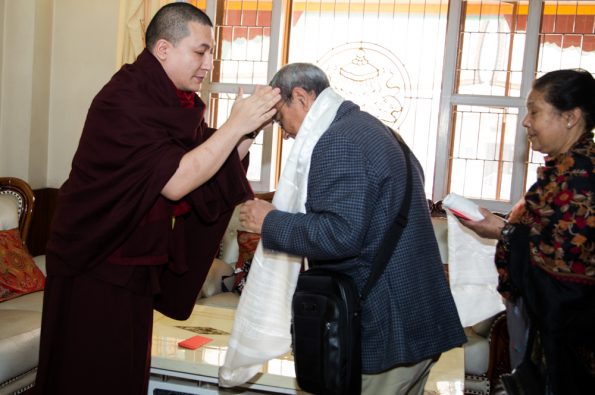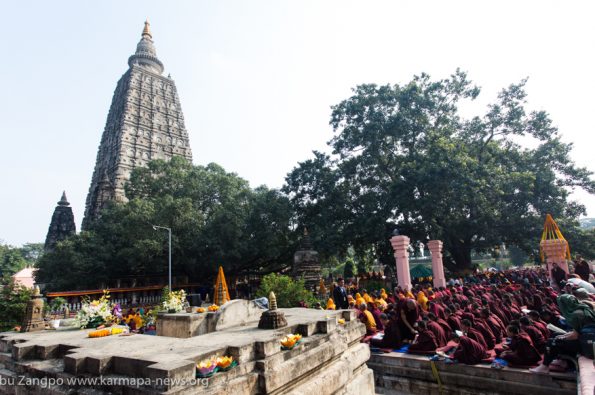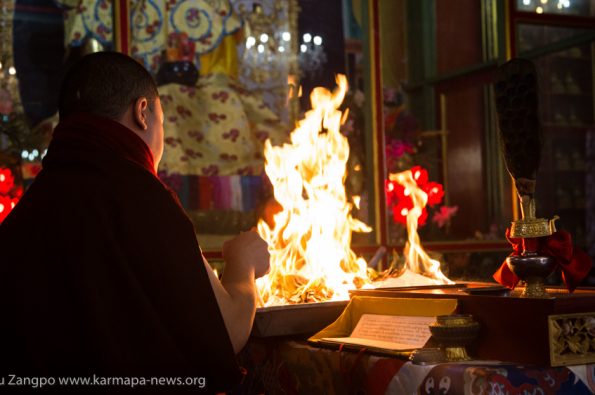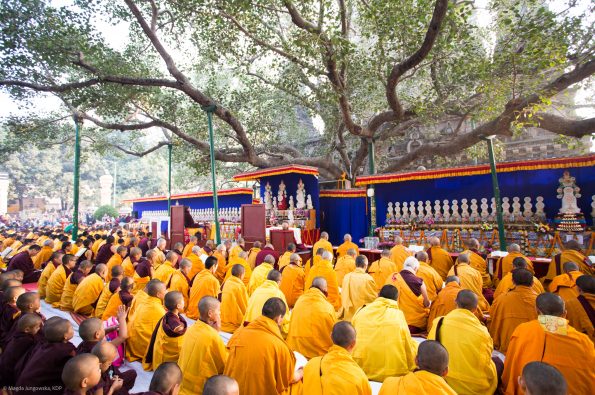The Gyalwa Karmapa went on a pilgrimage, visiting the holy sites in the vicinity of Bodhgaya
January 3, 2011: Kunzig Shamar Rinpoche gavea speech to Sangha And Devotees
One day after the end of the Kagyu Mönlam, Künzig Shamar Rinpoche gave a speech in front of the assembled monastic sangha and lay devotees of Rumtek. The venue of the meeting was the Sujata Hotel in Bodhgaya.
January 4 to 6, 2011: Gyalwa Karmapa Went Pilgrimage with Prof. Sempa Dorje
Between January 4 and 6, 2011, the Gyalwa Karmapa went on a pilgrimage, visiting the holy sites in the vicinity of Bodhgaya.
The first destination on January 4 was a Mahakala Cave (Mahakala – lit. Great Black One, a protector of the Buddha’s teaching) not far from Bodhgaya, associated with a sacred place known as Silwa Tsal (Cool Grove). It is said that the Mahasiddha (great accomplished yogi) Shawaripa was meditating in this cave when the dharma protector Mahakala showed himself to him.
Silwa Tsal also refers to one of the famous Eight Great Charnel Grounds mentioned in the Buddhist scriptures. Gyalwa Karmapa also visited this charnel ground, which is located below the Mahakala Cave.
The next stops were the place where the Buddha practised austerities for six years prior to going to Bodhgaya and attaining enlightenment and the place where Sujata offered milk to the starving Prince Siddhartha. The tree under which this historic event took place still exists today.
That day’s pilgrimage ended at the Mahabodhi Stupa where Gyalwa Karmapa visited two special places: Atahasa to the north-east, with its ancient stone mandala, and Mujabindo Sarovar, a lake located in the south where, as the Buddha was sitting in meditation, the local nagas (water spirits) produced violent storms to create obstacles to his practice and realisation. However, the Buddha-to-be was saved by one of the Nagas, Mujabindo, after whom this lake is named.
Having visited these places, Gyalwa Karmapa did circumambulations, followed by an increasingly large number of devotees.
On the next day, Gyalwa Karmapa went to the city of Rajgir (Rajgriha – Palace of the King), and from there first up to Vulture Peak, where the Buddha taught the Prajnaparamita (Perfection of Wisdom) Sutra and a great number of Mahayana teachings, after having performed a great number of miracles in Shravasti.
Next, it was the ropeway up to Ratnagiri (Jewel Mountain) where Nichidatsu Fujii (1885-1985), a Buddhist monk from Japan and founder of the Nipponzan-Myohoji Buddhist sect, established a peace pagoda. Nichidatsu Fujii set an example for world peace by establishing peace pagodas around the world, and one or these is the pagoda at Rajgir, known as Vishwa Shanti Stupa.
The Buddha himself taught many Mahayana Sutras on Ratnagiri Mountain, including the famous Shalistamba Sutra.
From there Gyalwa Karmapa went down to the Hot Springs in Rajgir, located at the foot of a mountain called Vipulagiri (Abundant Mountain). This place is considered to be the holy place of one of the Sixteen Arhats. A great number of steps lead up from the hot springs to a cave known as Saptaparni Cave (Cave of Seven Leaves). There, two months after the Buddha’s Parinirvana (Passing into Nirvana), five hundred Arhats, led by Mahakashyapa, gathered to collect the teachings given by the Buddha, structuring them into the so-called Three Baskets (Vinaya, Sutra and Abidharma). This gathering is known today as the First Buddhist Council.
Nearby on the same mountain there is the place where the founder of the Jain religion remained in strict meditation for twelve years, developing radical renunciation for all worldly concerns, such as food, clothing, shelter and so on. Therefore, this place is also a very important pilgrimage sites for followers of Jainism.
The next destination was the nearby Kashyap Cave, located at the base of the mountain, where many Arhats, including Mahakashyapa, spent extended periods of time in meditation.
According to the Mahayana (Great Vehicle) tradition, it is said that Manjushri, Maitreya and Vajrapani gathered there with an assembly of 800,000 bodhisattvas, collecting all the teachings of the Mahayana.
The morning of the third day was spent at the excavation site of the ancient university of Nalanda.
Nalanda was one of the world’s first residential universities, and remains one of the most famous ones. In its heyday it accommodated over 10,000 students and 2,000 teachers. The site of Nalanda was five miles wide and seven miles long and had a variety of lakes and parks. It had eight separate compounds and ten temples, along with many other meditation halls and classrooms. The library was located in a nine-storied building where meticulous copies of texts were produced. The university was considered an architectural masterpiece, and the subjects taught at Nalanda covered every field of learning. The great Mahasiddha and Kagyu forefather Naropa was gatekeeper at Nalanda before he left in search of his guru Tilopa, and Nalanda is also the place where Shantideva composed his famous Bodhicarya-avatara.
In the afternoon Gyalwa Karmapa visited the Nalanda Museum, which contains a large number of manuscripts and shows many examples of the items that have been excavated.
In the vicinity there is also a black Buddha statue, excavated from the grounds of Nalanda, which the local people refer to as Tili Buddha (Oil Buddha). It is reputed for its healing powers: whenever a child gets sick his or her parents will pay a visit to this statue and anoint the Buddha’s belly with oil, and it is said that once they have done so, the child invariably gets cured.
The next destination was a place called Bihar Shari, located at about twelve kilometres from Nalanda. This place lies at the base of a mountain on top of which there is a Vihar (Buddhist temple). The name of this Vihar is Pullahari, and it was created by one of the kings of Magadha who offered it to the practitioners of the secret mantra. One of these accomplished practitioners residing in Pullahari was Naropa, and when Marpa the great translator arrived in India after his long and arduous journey from Tibet it was here that he met with his guru Naropa for the first time and received the transmission of the secret teachings from him.
On the way back to Bodhgaya, one last stop was made at a place where deep imprints of chariot wheels can be seen on the stony ground. The story says that these marks were left by the chariot of King Bimbisara, a close disciple and supporter of the Buddha. When the horse pulling the chariot spotted the Buddha who was coming in their direction on his way from Rajgir, it started running towards him, thus causing the wheels to leave deep tracks in the stone.
Prof. Sempa Dorje, a great scholar and the Gyalwa Karmapa’s private tutor, was present during the entire pilgrimage tour and gave explanations on every single site.
January 7, 2011: Dr. Arvind Kumar Took Buddhist Refuge From Gyalwa Karmapa
On January 7, 2011, a public figure of high standing paid a visit to Gyalwa Karmapa: Dr. Arvind Kumar is the Vice-Chancellor of Magadh University, Bodh Gaya, Bihar. He has 32 years’ of experience as an outstanding teacher and researcher.
He was a recipient of National Merit Scholarship all through his college and university years and got meritorial fellowship of CSIR, New Delhi. He has been awarded several gold medals for his outstanding achievements, particularly in the field of environmental sciences.
Professor Kumar has got more than 225 research articles and reviews published in national as well as international journals, and has authored/edited more than 83 books in various fields of Environmental Sciences.
It is Professor Kumar who organized the 1st National Conference of Environmental Scientists in 2002 in S. K. M. University, Dumka.
At present, Dr. Kumar is a member of the Jharkhand State Pollution Control Board, Ranchi, President of the International Society for Ecological communications (Argentina), and Secretary General of the Society of Environmental Sciences.
During his visit to Gyalwa Karmapa Dr. Kumar was accompanied by Mr. Armanath Pathak, a co-worker and his representative during the celebration of the first Karmapa Düsum Khyenpa’s 900th anniversary. Mr. Armanath Pathak also works as a reporter for the Hindustan Times.
Upon their arrival, Dr. Kumar and Mr. Pathak were taken to Gyalwa Karmapa’s room where they asked to take the Buddhist refuge with him. Karmapa complied with their request and performed the refuge ceremony, transmitting the refuge vows to them, cutting a symbolic strand of their hair and giving them refuge names.
The taking of refuge in the Buddha, the Dharma (his teaching) and the Noble Sangha (the guides and friends on the way to Buddhahood) marks the first step of an individual on the Buddhist path.









































